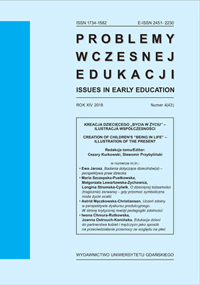Holistic education – a model based on three pillars
from cognitive science. An example from science education
Holistic education – a model based on three pillars
from cognitive science. An example from science education
Author(s): Eliza Rybska, Maciej BłaszakSubject(s): Education
Published by: Uniwersytet Gdański
Keywords: holistic education, neural networks; dimensions of holistic education – sensibility; functionality; rationality
Summary/Abstract: In this conceptual article we present a modular model of holistic education. Within this approach, an educational activity (and a child’s learning that derives from it) can be characterized in three dimensions: 1) safety, inclusion and participation; 2) interaction, cognition and representation; and 3) affective action leading to imagination and creativity. A holistic approach nurturing the full cognitive development of a child requires going beyond what a conventional school offers, but still presumes designed but liberating processes. We provide a neurobiological argument for holistic education supported by evidence for the featured three dimensions of holistic education along with illustrative examples.
Journal: Problemy Wczesnej Edukacji
- Issue Year: XVI/2020
- Issue No: 2 (49)
- Page Range: 45-59
- Page Count: 15
- Language: English

